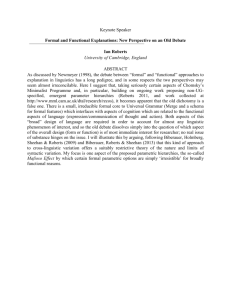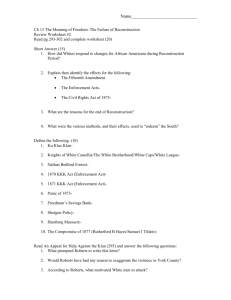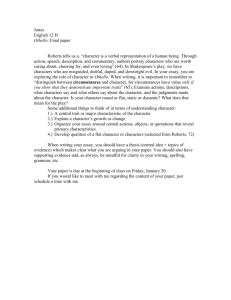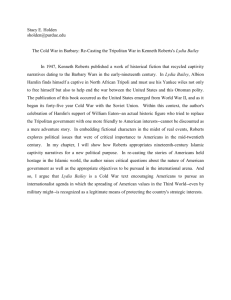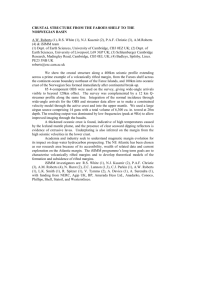A SPACE OF ONE'S OWN: READING MICHÈLE ROBERTS' URBAN
advertisement
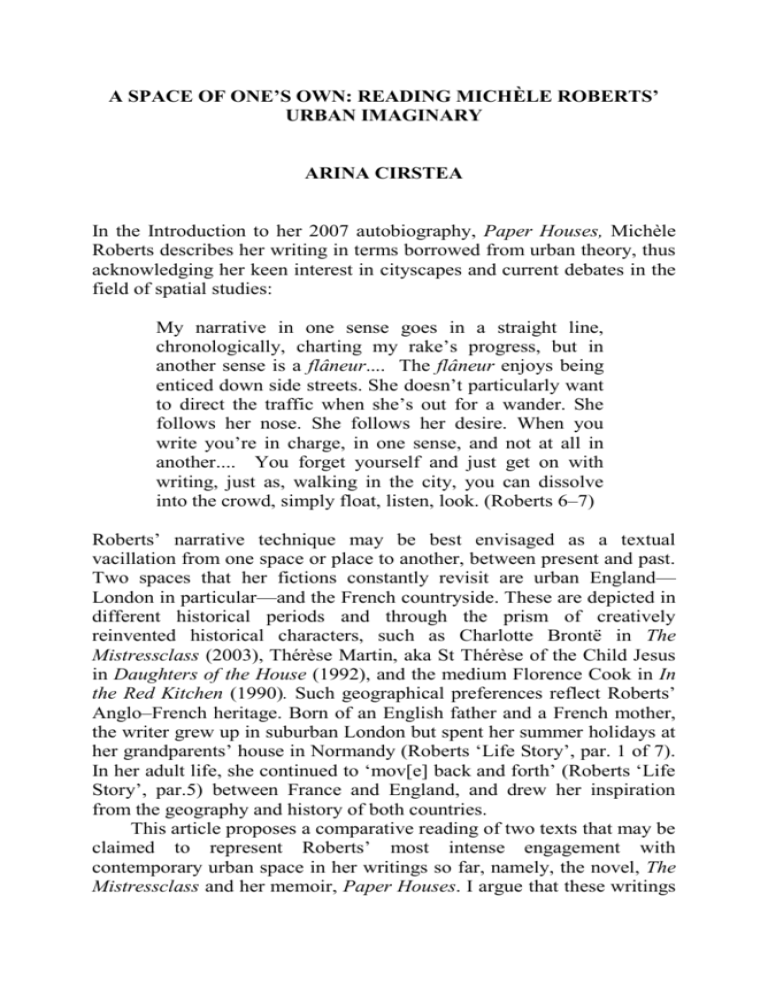
A SPACE OF ONE’S OWN: READING MICHÈLE ROBERTS’ URBAN IMAGINARY ARINA CIRSTEA In the Introduction to her 2007 autobiography, Paper Houses, Michèle Roberts describes her writing in terms borrowed from urban theory, thus acknowledging her keen interest in cityscapes and current debates in the field of spatial studies: My narrative in one sense goes in a straight line, chronologically, charting my rake’s progress, but in another sense is a flâneur.... The flâneur enjoys being enticed down side streets. She doesn’t particularly want to direct the traffic when she’s out for a wander. She follows her nose. She follows her desire. When you write you’re in charge, in one sense, and not at all in another.... You forget yourself and just get on with writing, just as, walking in the city, you can dissolve into the crowd, simply float, listen, look. (Roberts 6–7) Roberts’ narrative technique may be best envisaged as a textual vacillation from one space or place to another, between present and past. Two spaces that her fictions constantly revisit are urban England— London in particular—and the French countryside. These are depicted in different historical periods and through the prism of creatively reinvented historical characters, such as Charlotte Brontë in The Mistressclass (2003), Thérèse Martin, aka St Thérèse of the Child Jesus in Daughters of the House (1992), and the medium Florence Cook in In the Red Kitchen (1990). Such geographical preferences reflect Roberts’ Anglo–French heritage. Born of an English father and a French mother, the writer grew up in suburban London but spent her summer holidays at her grandparents’ house in Normandy (Roberts ‘Life Story’, par. 1 of 7). In her adult life, she continued to ‘mov[e] back and forth’ (Roberts ‘Life Story’, par.5) between France and England, and drew her inspiration from the geography and history of both countries. This article proposes a comparative reading of two texts that may be claimed to represent Roberts’ most intense engagement with contemporary urban space in her writings so far, namely, the novel, The Mistressclass and her memoir, Paper Houses. I argue that these writings PEER ENGLISH challenge the reader’s urban imaginary by projecting onto the familiar fabric of present–day London insights provided by late twentieth– century feminist discourse to urban space. Roberts’ imaginative mapping focuses in particular on revisiting and undermining the set of restrictions that have historically regulated gender behaviour in the space of the city, most often with a view to limiting women’s access to the exhilarating pleasures as well as hazards of the public arena. Whilst questioning the lingering authority of some of these restrictions, Roberts’ texts also celebrate the skill of women who have been, and continue to be, able to circumvent them with the force of their imagination. She shows how women can turn the public space of the city into a space of their own. In 1929, Virginia Woolf famously argued that women needed financial and spatial independence—‘five hundred a year each of us and rooms of our own’ (149)—in order to free their all–important creative imagination. In this article, I suggest that by contrast, Roberts’ women only require the skilful use of their creative imagination to secure a range of financial and spatial privileges, which includes a home of their own right in the centre of a hectic city. In the excerpt quoted earlier, Roberts suggests that through her writing, she feels empowered to take ‘charge’ of the city and mould it into her personal ‘paper house’, while at the same time experiencing an exhilarating feeling of boundary dissolution, of becoming one with the spaces she loves (Paper Houses 7). In Paper Houses and The Mistressclass, Roberts’ re–writing of London is complex and multifarious. While the autobiographical Paper Houses brings into focus her life in London between 1971 and 1995, The Mistressclass deploys an experimental narrative technique to draw together key themes in the author’s work, including the creative revision of cultural history and the contrast between metropolitan London and the French country village. More specifically, the latter text intertwines an imaginative reinterpretation of Brontë’s biography with the life stories of three contemporary Londoners: Vinny, an unpublished poet; her sister Catherine, a literature teacher and secret writer of popular romances’ and the latter’s husband—as well as Vinny’s former fiancé —Adam, a writer who is suffering from writer’s block who has just taken up a job as albuilder. Roberts’ engagement with contemporary London in these texts is marked by fascination with, and love for, the city. She shares with writers such as Doris Lessing the view that a city is made up of the ‘histories and lives and loves of people’ (Four–Gated City 66). Accordingly, in The Mistressclass, Vinny attempts to ‘make sense’ of London by tracing the stories of its long departed inhabitants: 42 PEER ENGLISH Dead writers, if she can track down the pavements over which they once trod, the beds in which they slept and made love, clarify and redefine her city, help her find her place among the living. By discovering their haunts she becomes an agent. She acts. The city becomes manageable, begins to make sense. She plants her own signposts around it, stringing together its parts into her own patterns. (Roberts 107) This passage briefly captures Vinny’s idiosyncratic approach to mapping the city, suggesting that for her the spirit of contemporary London is underwritten by past and present life stories. A similar point is made in Paper Houses, where Roberts notes that writing the history of a city means ‘listening to the voices of the dead’ and ‘bearing witness to other people’s stories as well as my own’ (115). For Vinny, this approach to urban history becomes an intense spiritual experience; ‘immortality was embodied inside language itself’ (The Mistressclass 108). As a consequence, Roberts’ London is a living organism that accommodates both traces of the past and seeds of the future. More importantly, Vinny’s comment draws attention to the extent in which the metropolis is also a ‘paper’ city, a space which is shaped by layers of subjective textual representations. One such representation spells out the historical norms regulating the behaviour of women in public and private space; throughout her work, Roberts takes an interest in the range of strategies used by women to question and evade these models. In Paper Houses, Roberts recalls her immense delight at walking in the streets of London. As a young woman, she embraced the space of the city with childish exhilaration and took pleasure even in the least agreeable of her discoveries: I was a flâneur walking about and bursting open with love for the London streets; then the internal and external worlds would fuse and I would experience the bliss that mystics feel, self all gone, just this flow of alive delight. One day I walked from Liverpool Street to Peckham, zigzagging through Southwark en route, registering horrible cages of jerry–built flats with the odd concrete play space attached fenced in with tall wire walls like a concentration camp, but also delighting in how at the end of every street the horizon altered, the perspective shifted. (Roberts 142) 43 PEER ENGLISH Roberts’ depiction of urban space is shaped by her engagement with urban and narrative theory. In this excerpt, she looks back at her younger self from her current position as a feminist author and Professor of Creative Writing, at least insomuch as the terms in which she couches her experience echo critical debates regarding the concept of flâneur. One of the most frequently invoked theories of flânerie is authored by Walter Benjamin, who defines the flâneur as a typical product of Western urban modernity between the 1830s–1860s. Typically the flâneur is a male observer, a wanderer who finds himself at home in the streets of the modern city. However, in Benjamin’s view the flâneur’s defining sphere is the private one. Even if his spatial domain is the street, he ‘turns the boulevard into an ‘intérieur’’ (Benjamin 37), that is he makes use of modern architectural style to project privacy onto the public spaces of the city. In the 1990s, Benjamin’s concept of flâneur started to be challenged by feminist theorists who take issue with its male–centredness. Rather than emphasizing the constraints on women’s access to city space, scholars such as Deborah Parson and Elizabeth Wilson reclaim the concept of flâneur from a feminist perspective, suggesting that despite the norms of propriety that historically have required ‘respectable’ women—particularly of the middle and upper classes—not to walk unchaperoned in public space, Victorian women developed a range of strategies to take possession of city streets. Roberts’ emphasis on the pleasure she experiences as a young woman roaming freely through the streets of London echoes these scholarly gendered debates surrounding city space. However, by describing her inner state as the ‘bliss mystics feel, self all gone’ (Paper Houses 42), Roberts also re–interprets flânerie as a form of spiritual engagement. She takes Benjamin’s argument a step further, proposing a view of the flâneur who not only turns the space of the city into ‘an intérieur’ but into a projection of their inner self. This merger of self and space provides the flâneur/euse with a new understanding of the world as well as a joyful sense of belonging. The subjective perceptions of cityscape vary with each of Roberts’ characters. In The Mistressclass, Vinny and Adam are drawn to the banks of Thames by the joys of flânerie and by other urban thrills: Vinny perched on the balustrade fronting the riverside aspect of the Vintners’ Building and smoked a cigarette, holding herself balanced with one hand. She swung her legs, gently beating the heels of her boots against the iron struts underneath her. Waiting to see what would 44 PEER ENGLISH happen next. To Adam, idly glancing down, she looked like any happy–go–lucky and idle tourist. (Roberts 18) In this passage Roberts casts her characters in stereotypical gender roles: the male flâneur takes pleasure from his scopic dominance over the vulnerable—and unsuspecting—female walker. However, the narrative gradually undermines these initial assumptions. While Vinny is a dedicated urban walker who enjoys her stroll by the river in sight of familiar buildings and the ‘benches she loved’ (The Mistressclass 17), she is in fact on the more purposeful pursuit of tracing her work of art— an effigy of the poet Shelley, which had been thrown into the river by a teenage gang. By beginning her narrative with an image of Shelley’s effigy floating aimlessly down the River Thames, Roberts suggests a further alternative reading of the flâneur as a lonely, helpless figure carried along by the urban crowd. This interpretation invokes Benjamin’s rapprochement between flânerie as a modern cultural practice and Poe’s short story ‘The Man of the Crowd’. In Benjamin’s view, Poe’s short story presents a negative projection of the flâneur as a neurotic urban dweller who ‘does not feel comfortable in his own company’ (Benjamin 48), and voices early modern anxieties about the impersonal character of urban space which are similarly presented in this passage: Perhaps it was a log, that dark shape, half submerged, propelled by the current from the direction of Blackfriars. Nobody except Adam took much notice.... Bulky and anonymous as a lost kitbag, the chunk of wood swayed along, floating gradually downstream, bobbing up and back in the wake of a passing launch. (Roberts, The Mistressclass 13) At the same time, the lost doll serves as a narrative device which unifies the perspectives of otherwise unrelated city dwellers. Their interest in the floating effigy, as well as their common habit of observation, bring together Adam and Vinny after many years of separation. Moreover, the episode plays down the impersonal character of cityscape by evincing its potential to lure the lonely flâneur into a pleasurable encounter, of a romantic or platonic kind. Later on in the novel, Adam expresses the desire to ‘go for a walk with Vinny’, ‘somewhere in the centre of the town, explore the deserted streets and alleys of the City’ (The Mistressclass 197) where they can talk ‘intimately’ in cafés (217). Flânerie as a lonely enterprise is thus 45 PEER ENGLISH superseded by companionable roaming through the city by the side of a beloved friend or potential lover. Alongside walking and observing, uninhibited communication plays an important role in this type of urban venture, which often includes a ‘static’ experience such as an amiable chat in a pub or café. Roberts’ own expeditions through London in Paper Houses are frequently marked by detours to favourite pubs or restaurants. In addition to walking, Roberts takes great pleasure in cycling alone or in the company of friends from one place of interest to another: The French (pub) in Dean Street was another favourite stopping–off point on my bicycle rides.... Feeling joyful often happened around Sarah LeFanu. One day [we] took some cocaine, hopped on to our bikes and sped across the river, making for Islington and a party. We rode abreast so we could chat as we went. (Roberts, Paper Houses 144) In Paper Houses, being ‘stoned’ (142) or ‘tipsy’ (145) is a state frequently associated with Roberts’ experience of London nightlife, in particular during the 1970s. In passages as the one above, dizziness induced by cocaine or alcohol goes hand in hand with the exhilaration of living in a city and age full of new possibilities, being young and trying out everything. In a similar episode, Roberts recalls that during a seaside expedition she and Sarah had a narrow escape when they tried rowing a boat out at sea after having drunk heavily (Paper Houses 145). In a city dotted with the headquarters of various revolutionary youth movements, from leftist activists and feminist groups to jazz and radical artists’ collectives, for Roberts, London pubs or party hopping in the city becomes a modality of mapping a space that rivals and complements the more conventional approach of flânerie. At the same time, informed by the feminist critique of flânerie, during her wanderings she is particularly sensitive to those challenges that betray the persistence of patriarchal views as to the role of women in public space: I was a flâneur, a flâneuse. However, lots of men assumed that as I was wandering the streets by myself I must be touting for business. Only men were flâneurs. A lone woman walking along the street was a street walker. Similarly, if you stood outside a pub, waiting for a friend, you’d be accosted non–stop. How much? 46 PEER ENGLISH the men would murmur, sidling up: how much? (Roberts, Paper Houses 185–86) The passage above clearly echoes feminist research on the Victorian and modernist city, in particular the views of scholars like Parsons who signal the ‘traditional interpretation of the city woman as a prostitute, walking in the city and developing ‘vagrant habits’, picking up men in parks and cafés’ (197). Whilst the relevance of this framework for 1970s and 1980s London may be questioned, Roberts’ implies that patriarchal gender norms continue to be deeply embedded in Londonese society. In fact, in search of ways to ward off such aggressive intrusions, Roberts falls back on the experience of her literary predecessors and dons ‘male dress’ like George Sand; her ‘version’ is ‘big overcoat, flat shoes’ (Paper Houses 186). This approach turns out to be particularly effective when accompanied by a range of complementary strategies available to every Victorian city dweller. In this respect, Victorianist scholar Judith Walkowitz points out that, whilst the solution of dressing up in male clothes was considered eccentric as well as inappropriate for ‘respectable’ ladies, Victorian women invested much energy in devising effective strategies of dealing with ‘unwanted admirers’ that accosted and harassed them in the streets of London (50–52). These included paying special attention to ‘gestures, movements and pace’, which had to be ‘always dignified and purposeful’ (52). Another popular solution was the organisation of ‘personal maps and proscribed zones’ (52) that could be used to plan a safe itinerary through the city. Elsewhere in the volume Roberts revisits the strategy of dressing up, noting that while at times she used clothes to become ‘invisible’ to the male gaze, at others she chose outfits to arrest and intrigue it: ‘I liked men looking at me and having to decode me’ (Paper Houses 188). Interestingly, some of these outfits are also Victorian (Paper Houses 188). I would argue that here Roberts advances a more recent feminist argument about women’s ability to question and subvert gender norms even in rigidly sexist historical contexts. While disguising the female body may provide limited access to male privileges, the intelligent and creative display of the same body is suggested to grant women a degree of autonomy and jouissance that asserts the authority exerted by the female subject over and beyond patriarchal constraints. The Mistressclass is also concerned with power negotiations in the public arena, but the emphasis is more prominently laid on the perspective of the twentieth–century city dweller. The novel reflects recent developments in urban sociology that link urban danger with gang violence. Such concerns are implied, for instance, by Vinny’s brief 47 PEER ENGLISH encounter with a group of hooded teenagers, who are ostensibly ‘trying to look fierce’ and ‘wanting her to feel threatened’ (The Mistressclass 16). ‘Humiliated’ (17) by Vinny’s attempt to deal with them in a nonchalant, friendly manner, the youths snatch the life–sized doll she is carrying and, in spite of her protests, tear it up and throw it into the Thames. The image of the teenagers tossing the doll ‘from hand to hand’ (17) amidst shouts and laughter, aggressively ‘tearing off’ its clothes and ‘kicking it to and fro’ may be seen as a warning against more sinister forms of urban violence, such as gang assault or rape. While Roberts appears to be more concerned with the inner world of her characters rather than the external dangers of city living, this episode presents a vivid picture of the type of violent encounter that the contemporary London flâneur/flâneuse needs to be prepared to negotiate during theirlroaming. An even more widely–spread form of urban aggression comes into focus when Vinny engages in a form of travel that is emblematic of late twentieth century Western life – driving. London traffic in particular is notoriously congested and requires a high level of technical as well as negotiation skills. Vinny is confronted with the belligerent attitude of drivers engaged in this traffic: Fellow drivers, stuck in neighbouring lanes at red lights or creeping past around packed roundabouts, took no notice of her odd passenger. When they hooted at her or gestured obscenely or deliberately nudged too close it was not because she had chosen to take a life–sized doll for an airing but because she was not aggressive enough in leaping through gaps or getting away from green lights and so was holding them up. (Roberts, The Mistressclass 14–15) Roberts hints that misogyny, which has been legally banned from the streets of the contemporary metropolis yet finds its way back in certain urban practices. It may be argued that the majority of people who find it perfectly acceptable to gesture ‘obscenely’ at female drivers from behind the wheel of their car would consider the same behaviour inappropriate in a different spatial context, such as walking in the street or shopping. Despite the dramatic intensity of such scenes, anxieties related to urban violence are not permitted to hinder either Roberts’ or Vinny’s progress through city streets, nor interfere with their unconventional mapping of London. Vinny shares Roberts’ own passion for literary history; in her expeditions through the city, she does not put on a man’s 48 PEER ENGLISH ‘roomy coat’ (The Mistressclass 105) to deter unwanted admirers, but for the practicality of its large pockets that can accommodate the various tools of her strange art: She maps the city by treading across its pavements and writing on them where appropriate.... Outside certain houses in certain streets Vinny stops, stoops and scrawls. A quotation, or the whole of a short poem; a name plus dates. The houses of famous writers are marked with blue plaques. So her services are not needed.... She walks to these sites anyway. To pay her respects. Then progresses on her solo pilgrimage tolother, unmarked shrines. (Roberts, The Mistressclassl105) This passage succinctly sums up Vinny’s idiosyncratic form of urban art. She has taken upon herself to mark the former residences of writers forgotten by official London history. By scribbling excerpts from their poetry or prose directly on the pavement, she produces a form of literary graffiti. Through this, she reshapes the map of contemporary London and invests the space of the city with personal meaning. At the same time, her ephemeral scribbling seeks to acknowledge the contribution of different literary texts—and in particular, the texts of women writers such as Jean Rhys and Katherine Mansfield—to shaping current perceptions of the metropolis. Like Roberts, Vinny enjoys ‘listening to the voices of the dead’ (Paper Houses 115) and regards the texts that past writers have left behind as ‘her way into the community of the dead’ (The Mistressclass 107). More than leaving undeletable marks on the spaces they occupied, the dead are precious ‘companions’ that help Vinny organise the ‘urban forest’ (107) into a coherent map she can make sense of. Vinny’s fascination with famous ‘[d]ead writers’ is also linked with her search of surrogate parental figures after having lost both her parents to cancer. While the idea of seeking compensation for lost affections in the realm of the literary and the imaginary is a widely–used literary trope, through Vinny’s unusual pilgrimage in the streets of contemporary London, Roberts reinforces a view of urban space a bearer of psychical, bodily and textual traces that bring together the past and future of a community. London is thus able to provide orphaned Vinny not only with a home, a familiar space she can call her own, but also with role models and a parentage of her choice. 49 PEER ENGLISH Vinny’s mapping of London proposes alternative images of the metropolis as a palimpsestic narrative, an organism bearing traces of its past lives in the plastic ‘veins and arteries’ hidden beneath its pavements (The Mistressclass 104), and finally a multilayered space in different stages of renovation; for all these cases, in those ‘pockets of older use tucked into the modern townscape the city swarms with ghosts’ (106). Roberts strives to make it clear that these possibilities are by no means exhaustive. In this respect, Vinny’s sister Catherine describes her own approach to the city in the following terms: People complained about the impersonality of cities, but that was only because they didn’t bother shopping in small shops, spending two minutes talking to the assistants who served them. When she and Adam decided to move to Fleet Halt and give up the flat, she had gone round and said goodbye to everyone. Uprooting yourself, you didn’t just leave a district, an urban landscape: you left local friends.... Now she was having to start that process of getting to know people all over again.... (Roberts, The Mistressclass 63) This passage indicates that, in her efforts to map the ‘urban forest’, Catherine resorts to the more conventional resources of socialisation— with the living rather than the dead. The thoughts voiced by Roberts’ character are reminiscent of Lessing’s claim that for ‘practised’ city dwellers London becomes ‘a conglomeration of villages’ from which they may choose one to live in (Walking in the Shade 164). Feminist scholar Christine Sizemore considers that an approach to the city that performs a selective appropriation of spaces on the basis of the individual’s personal needs and relationships is characteristic of female city dwellers (‘In Pursuit of the English’ 139). However, Roberts’ texts suggest that women have many alternative ways of successfully negotiating the public space of the metropolis, and that choosing the most appropriate is often the key to the healthy social and psychic development of an individual. Admittedly, one of the most poignant of these strategies falls back on Sizemore’s concept of selective mapping. Quite often, Roberts’ characters rely on a city map with the home at its centre. By entitling her autobiography Paper Houses, Roberts calls attention to the fact that in this volume she rewrites her life not as a traditional Bildungsroman, but rather as a progression from one (urban) home to another. The most notable exception to this narrative technique is the period Roberts lived 50 PEER ENGLISH in Florence with her first husband William. Rather than making the object of a separate section, the episode is included in the chapter entitled ‘Bayswater’ because the couple also lived for a short while in a Bayswater flat. By organising her chapters around specific spatial references, Roberts suggests that different stages in her personal development are inextricably linked with the places she lived in, and more concretely with the name of a particular London street (Holloway Road), district (Bayswater, Notting Hill), or, in other cases, a town or city outside London (Wivenhoe; Bangkok; Cambridge, Massachusetts). The syntagm ‘paper houses’ further hints at the identification between text and space, both public and private. While for Roberts diaries function as a shelter— a ‘paper house’or a ‘paper cupboard’ (Paper Houses 253)—in which she can store her inmost thoughts, a home is similarly a ‘psychic space’ that contains and shapes the inner lives of its inhabitants (Paper Houses 307). Roberts confesses her great satisfaction at finding such intuitions confirmed in the work of philosopher Gaston Bachelard: ‘Later on in 2002 I read Bachelard’s The Poetics of Space, in which he talks about the emotional shapes of the spaces inside houses and flats, and felt pleased that I’d got there independently’ (308). Given Roberts’ self–confessed interest in Jungian psychology (‘The Woman’ 62), it is not a surprise that she feels an affinity with Bachelard who, during an era dominated by Freudian psychoanalysis, famously rejected Freud’s approach to the unconscious and turned to Jungian intuitions about the human psyche. Bachelard’s Poetics of Space is concerned with the description and analysis of the ‘felicitous spaces’ (xxxi) that shelter the healthy psyche, and challenges Freud’s rather dramatic description of infant psychology by arguing that ‘life begins well, it begins enclosed, protected, all warm in the bosom of the house’ (7). Moreover, Bachelard shows an interest in what he terms as the ‘phenomenology of the soul’ (xvii), thus following Jung in acknowledging the spiritual dimensions of the human psyche, and implicitly rejecting Freud’s scientific materialism.1 In spite of her vocal criticism of Catholicism and institutional religion (Paper Houses 16, 332), in Roberts’ work the description of spiritual experiences, often in a religious form, occupies a central position. We may of course invoke Roberts’ own argument that her Catholic upbringing has left traces impossible to wipe away in later life (Paper Houses 332). Notwithstanding, in view of her predilection for spiritual experiences of a positive kind, it seems that despite her formal rebellion Roberts is receptive to the intrinsic value of religious experience, and attempts to approach Christian spirituality on her ownlterms. 51 PEER ENGLISH From this perspective, the structure of Roberts’ autobiography invites the reader to draw a parallel between the desire and effort to possess a house of one’s own and the spiritual pilgrimage of the Christian hero/ine. A pilgrim through the alien spaces of many rented houses and flats, Roberts experiences a moment of ultimate spiritual revelation when she finally becomes mistress of her own home: ‘My house, when I bought it, represented to me the maternal body; a myth of a daughter and mother reunited. Paradise lost but then regained’ (Paper Houses 336). A similar desire to possess a house of her own dominates the otherwise unconventional spatial behaviour of Vinny in The Mistressclass. After years of ‘queuing, persuading, complaining, haranguing, arguing’, Vinny regards the acquisition of a ‘poky’ council flat as a ‘triumph’ (53). When, at the end of the novel, she cleans and tidies the French cottage of Adam’s father, she provides a view of the home that recalls her approach to mapping the city previously discussed in this paper: She enjoyed the transformation she effected.... You had to let a house get dirty in order to demonstrate and enjoy its metamorphosis from grubby hovel into sunlit airy space smelling of flowers and beeswax and soap. The house a palimpsest: layers of memories of what it was like before; its clotted grime and filth. Other people’s dirt always seemed worse than one’s own: there was an extra, aggressive pleasure in getting rid of it. Housework could also be enjoyably narcissistic: cherishing the house you cherished yourself. (Roberts, The Mistressclass 274) I suggest that the metaphor of the ‘palimpsest’ provides the link between Vinny’s and Roberts’ approach to both public and private spaces. Both can absorb in their fabric successive layers of historical traces, and as a result, both need to be creatively reshaped to fit the individual needs of the here and now. In this respect, Vinny sees housework as a strategy to become acquainted with, and (finally) overwrite, the traces of other people’s lives that become embedded in domestic space. Similarly, she uses her idiosyncratic form of literary mapping as a way to remember, and often rewrite, the history of London, and in the process make herself at home in the metropolis. Paper Houses provides several poignant descriptions of the home as a fluid, flexible space mirroring the changes in the lives of its inhabitants. In the ‘Bayswater’ chapter, the moment Roberts starts 52 PEER ENGLISH feeling dissatisfied with her new status as a (house)wife, the flat she shares with her husband becomes ‘William’s place. He controlled it’ (253). Later on, while their relationship is rapidly deteriorating, she couches her presence in this flat in the following terms: I tried to keep up. I tried to keep the house up. I couldn’t. It was crumbling like my marriage and I felt like Humpty Dumpty as the main room tumbled, vanished, its walls pulled down. The roof lifted off like a lid, replaced with a canvas. I felt I was collapsing too. I was the house falling down. (Roberts, Paper Housesl268) The broken, wounded or otherwise disintegrating body of the house mirrors the fragmented identities of its inhabitants, their inability to see their lives as a coherent, meaningful story. Roberts admits to a fascination with this image of the house as a broken body, which she returns to in the description of the domestic space associated with her second marriage. While this marriage is generally described as a harmonious, fulfilling relationship, the house she shares with her husband Jim, his ex–wife Linda, and Jim and Linda’s two sons, is seen as ‘a house breathing history; it seemed alive to me, like a body’ (Paper Houses 306). Roberts confesses to having perceived this unconventional family home as a wounded, ‘broken’ body, which reflected the dissolution of Jim’s first marriage through the awkward separation between Linda’s large, ‘neat and clean’ ground floor quarters and Jim’s ‘run–down’ attic (307–8). She also recollects taking up renovation work once again, this time in the desire to assert her right to the space she occupies in her husband’s home and life, and to ‘hold up the house’— and implicitly their marriage—‘with the force of gleaming white paint’l(307). To conclude, many of Roberts’ texts depict a quest for a space of one’s own. In the public domain, this quest is typically accomplished through creative mapping, which tames and appropriates the chaotic space of the contemporary city. In this essay I have suggested that the success of this mapping relies on a similar effort of appropriation in the private domain, which requires individuals to actively conceive for themselves the home that Bachelard describes as the felicitous space of the healthy unconscious. This home, defined by such features as unity, harmony and coherence, provides a reassuring point of reference in their negotiations with the inner and outer world, and is quite unequivocally associated with the womb. The association reaches its culmination in 53 PEER ENGLISH Paper Houses, where home ownership is described as ‘the myth of a daughter and a mother reunited’ (336). This in turn can be linked back to Roberts’ description of flânerie as a mystical experience, through which the flâneur succeeds in becoming one with the city. As a result, the pervading insight of Roberts’ urban writing seems to be that the rhetorical distinction between public and private space is an arbitrary one, whereas for the successful urban dweller the city and the home merge into, and complete, each other. NOTES Jung’s famous theory of archetypes provides the basis for his understanding of spirituality (Aziz 46). By postulating that human beings possess not only an individual, but also a (shared) collective unconscious, Jung makes possible the interpretation of religious experience as a manifestation of archetypes (primordial components of the collective unconscious (Works 8 par.437)) at the level of consciousness. Jung’s theory was met with mixed reception; for an in– depth analysis of its cultural and psychotherapeutic implications, see Aziz (especially 167–223). 1 WORKS CITED Aziz, Robert. C.G.Jung’s Psychology of Religion and Synchronicity. New York: State University of New York Press, 1990. Bachelard, Gaston. The Poetics of Space. Boston: Beacon Press, 1969. Benjamin, Walter. Charles Baudelaire: A Lyric Poet in the Era of High Capitalism. Trans. Harry Zohn. 2nd ed. London and New York: Verso, 1997. Jung, Carl G. The Collected Works of C.G.Jung. Ed. Herbert Read et.al. 20 vols. London: Routledge and Kegan Paul, 1960. Vol 8: The Structure and Dynamics of the Psyche. Trans. R.F.C. Hull. Lessing, Doris. Walking in the Shade. Volume Two of My Autobiography, 1949–1962. London: Flamingo, 1998. Parsons, Deborah L. Streetwalking the Metropolis: Women, the City and Modernity. Oxford: Oxford University Press, 2000. Roberts, Michèle. ‘The Woman Who Wanted to be a Hero’. Walking on the Water. Women Talk About Spirituality. Eds. Jo Garcia and Sara Maitland. London: Virago, 1983. 50–66. ———. The Mistressclass. London: Virago, 2007 [2003]. 54 PEER ENGLISH ———. Paper Houses. A Memoir of the 1970s and Beyond. London: Virago, 2007. ———. ‘Life Story’. Michèle Roberts. London Web Collective, 2010. 17 February 2013. <http://www.micheleroberts.co.uk/ life_story.htm> Sizemore, Christine. ‘In Pursuit of the English: Hybridity and the Local in Doris Lessing's First Urban Text’. The Journal of Commonwealth Literature 43 (2008): 133–144. Sage Journals Online. 30 January 2009. Walkowitz, Judith R. City of Dreadful Delight. Narratives of Sexual Danger in Late Victorian London. London: Virago, 1992. Wilson, Elizabeth. The Contradictions of Culture. Cities: Culture: Women. London: Sage, 2001. Woolf, Virginia. A Room of One’s Own. Three Guineas. Oxford: Oxford University Press, 2000. 55
